借助云開發(fā)實(shí)現(xiàn)小程序朋友圈的發(fā)布與展示
隨著小程序云開發(fā)越來越成熟,現(xiàn)在用云開發(fā)可以做的事情也越來越多,今天就來帶大家實(shí)現(xiàn)小程序朋友圈功能。
創(chuàng)新互聯(lián)專注于企業(yè)全網(wǎng)整合營銷推廣、網(wǎng)站重做改版、赤峰網(wǎng)站定制設(shè)計(jì)、自適應(yīng)品牌網(wǎng)站建設(shè)、H5高端網(wǎng)站建設(shè)、商城開發(fā)、集團(tuán)公司官網(wǎng)建設(shè)、外貿(mào)營銷網(wǎng)站建設(shè)、高端網(wǎng)站制作、響應(yīng)式網(wǎng)頁設(shè)計(jì)等建站業(yè)務(wù),價(jià)格優(yōu)惠性價(jià)比高,為赤峰等各大城市提供網(wǎng)站開發(fā)制作服務(wù)。
知識(shí)技能點(diǎn)
- 1,小程序云開發(fā)
- 2,小程序云存儲(chǔ)
- 3,小程序云數(shù)據(jù)庫
- 4,圖片大圖預(yù)覽
- 5,圖片選擇與刪除
先給大家畫個(gè)發(fā)布的流程圖
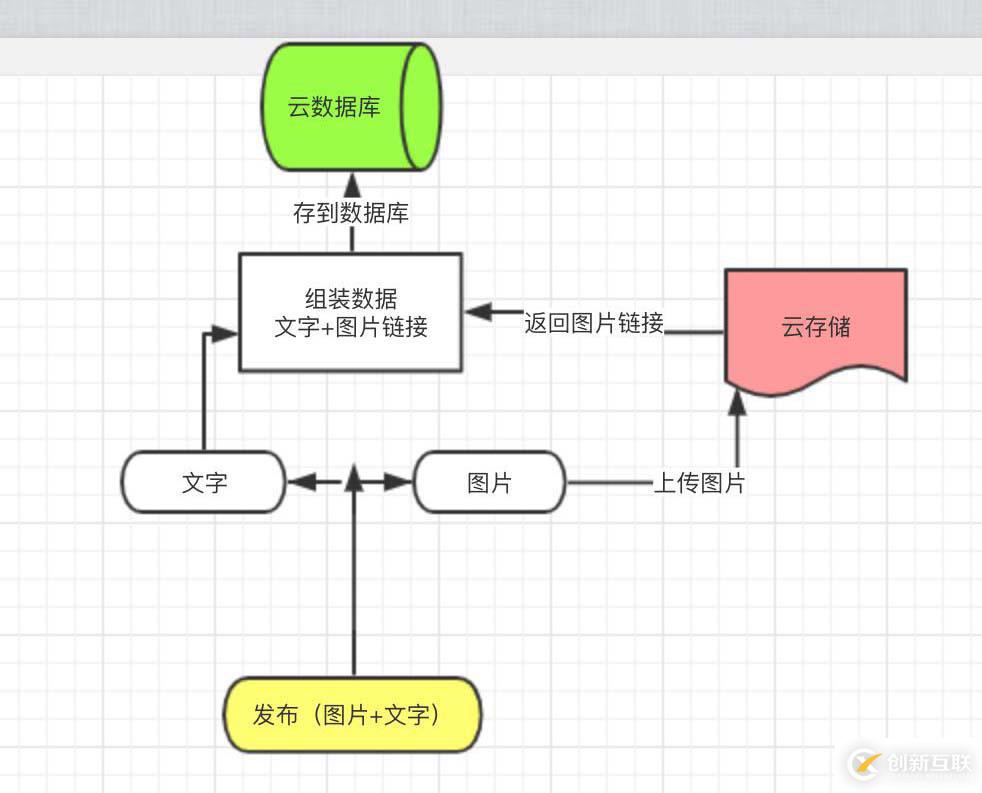
下面是我們真正存到數(shù)據(jù)庫里的數(shù)據(jù)。
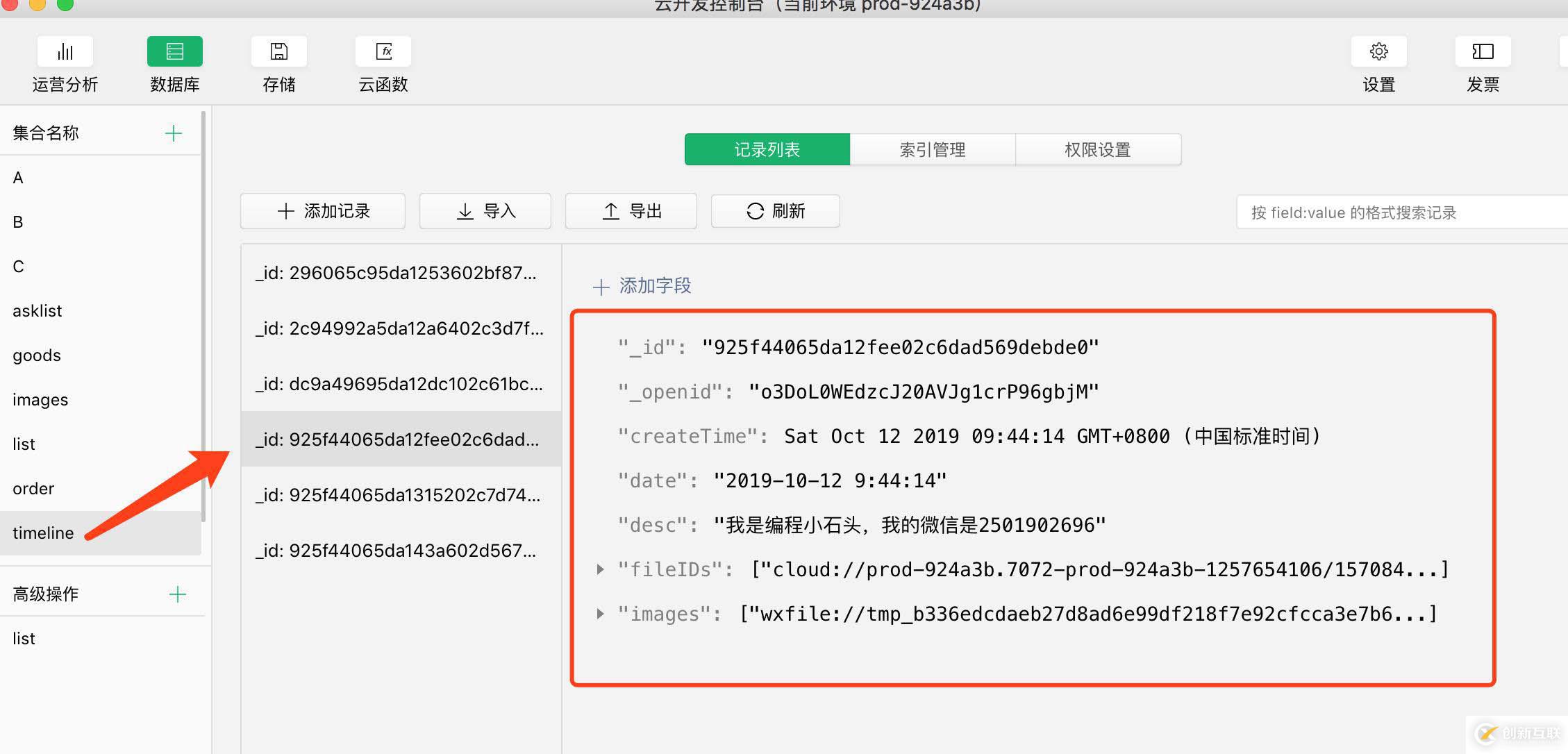
然后我們?cè)谂笥讶撝恍枰?qǐng)求數(shù)據(jù)庫里的數(shù)據(jù),然后展示到頁面就如下圖所示
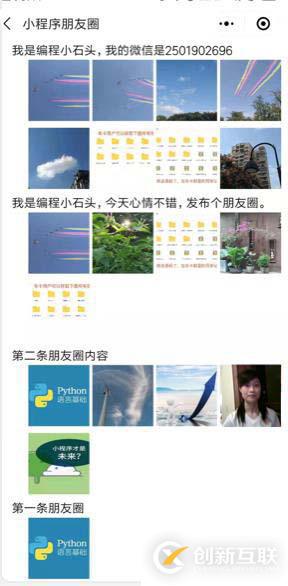
所以我們接下來就來實(shí)現(xiàn)發(fā)布和展示的功能
發(fā)布朋友圈
一,首先要?jiǎng)?chuàng)建一個(gè)小程序項(xiàng)目
這里就不多說了,如果你還不知道如何創(chuàng)建小程序項(xiàng)目可以去翻看下我之前的文章,也可以看下我錄制的《10小時(shí)零基礎(chǔ)入門小程序開發(fā)》
- 注意:一定要用自己的appid,所以你需要注冊(cè)一個(gè)小程序(個(gè)人的就行)
二,創(chuàng)建發(fā)布頁面
我們發(fā)布頁布局比較簡(jiǎn)單,一個(gè)文字輸入框,一個(gè)圖片展示區(qū)域,一個(gè)發(fā)布按鈕。
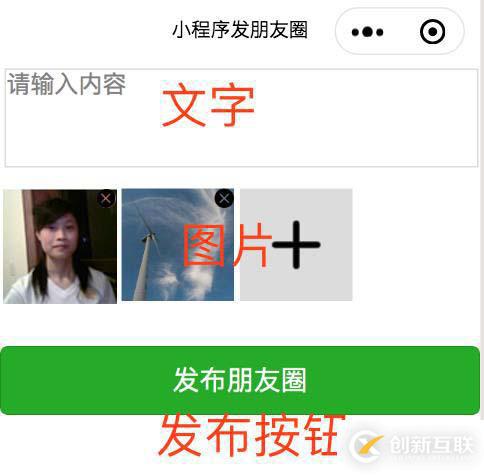
先把發(fā)布頁布局wxml貼出來
<textarea class="desc" placeholder="請(qǐng)輸入內(nèi)容" bindinput="getInput" />
<view class="iamgeRootAll">
<view class="imgRoot" wx:for="{{imgList}}" wx:key="{{index}}" bindtap="ViewImage" data-url="{{imgList[index]}}">
<view wx:if="{{imgList.length==(index+1)&& imgList.length<8}}" class="imgItem" bindtap="ChooseImage">
<image class="photo" src="../../images/photo.png"></image>
</view>
<view wx:else class="imgItem" data-index="{{index}}">
<image class="img" src='{{item}}' mode='aspectFill'></image>
<image class="closeImg" bindtap="DeleteImg" src="../../images/close.png" data-index="{{index}}"></image>
</view>
</view>
<!-- 一開始用來占位 -->
<view wx:if="{{imgList.length==0}}" class="imgItem" bindtap="ChooseImage">
<image class="photo" src="../../images/photo.png"></image>
</view>
</view>
<button type="primary" bindtap="publish">發(fā)布朋友圈</button>這里唯一的難點(diǎn),就是下面的圖片分布,因?yàn)槲覀兠看斡脩暨x擇的圖片個(gè)數(shù)不固定,這就要去分情況考慮了。
wx:if="{{imgList.length==(index+1)&& imgList.length<8}}"這段代碼是用來控制我們發(fā)布的那個(gè)? 號(hào)的顯示與隱藏的。
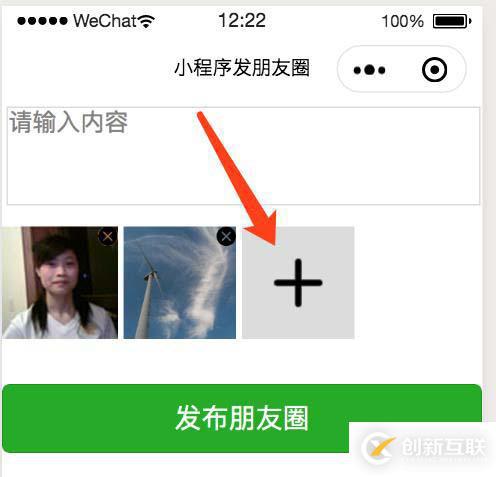
這個(gè)?號(hào)有下面三種情況需要考慮
- 1,沒有添加任何圖片時(shí),只顯示?號(hào)
- 2,有圖片,但是不滿8條時(shí),我們需要展示圖片和加號(hào)。
- 3,有8張圖片了,加號(hào)就要隱藏了。
仔細(xì)看下上面的wxml代碼,代碼里都有體現(xiàn)。
三,實(shí)現(xiàn)圖片選擇和顯示功能
圖片選擇很簡(jiǎn)單,就用官方的api即可。實(shí)現(xiàn)代碼如下
//選擇圖片
ChooseImage() {
wx.chooseImage({
count: 8 - this.data.imgList.length, //默認(rèn)9,我們這里最多選擇8張
sizeType: ['original', 'compressed'], //可以指定是原圖還是壓縮圖,默認(rèn)二者都有
sourceType: ['album'], //從相冊(cè)選擇
success: (res) => {
console.log("選擇圖片成功", res)
if (this.data.imgList.length != 0) {
this.setData({
imgList: this.data.imgList.concat(res.tempFilePaths)
})
} else {
this.setData({
imgList: res.tempFilePaths
})
}
}
});
},這里單獨(dú)說明下 8 - this.data.imgList.length。因?yàn)槲疫@里規(guī)定最多只能上傳8張圖片。所以用了count8 ,至于后面為什么要減去this.data.imgList.length。主要是我們用戶不一定一次選擇8張圖片,有可能第一次選擇2張,第二次選擇2張。。。
所以我們做選擇時(shí),每次傳入的數(shù)量肯定不一樣的。而這個(gè)imgList.length就是用戶已經(jīng)選擇的圖片個(gè)數(shù)。用8減去已選擇的個(gè)數(shù),就是下次最多能選擇的了。
上面代碼在選擇成功后,會(huì)生成一個(gè)臨時(shí)的圖片鏈接。如下圖所示,這個(gè)鏈接既可以用來展示我們已經(jīng)選擇的圖片,后面的圖片上傳也要用到。
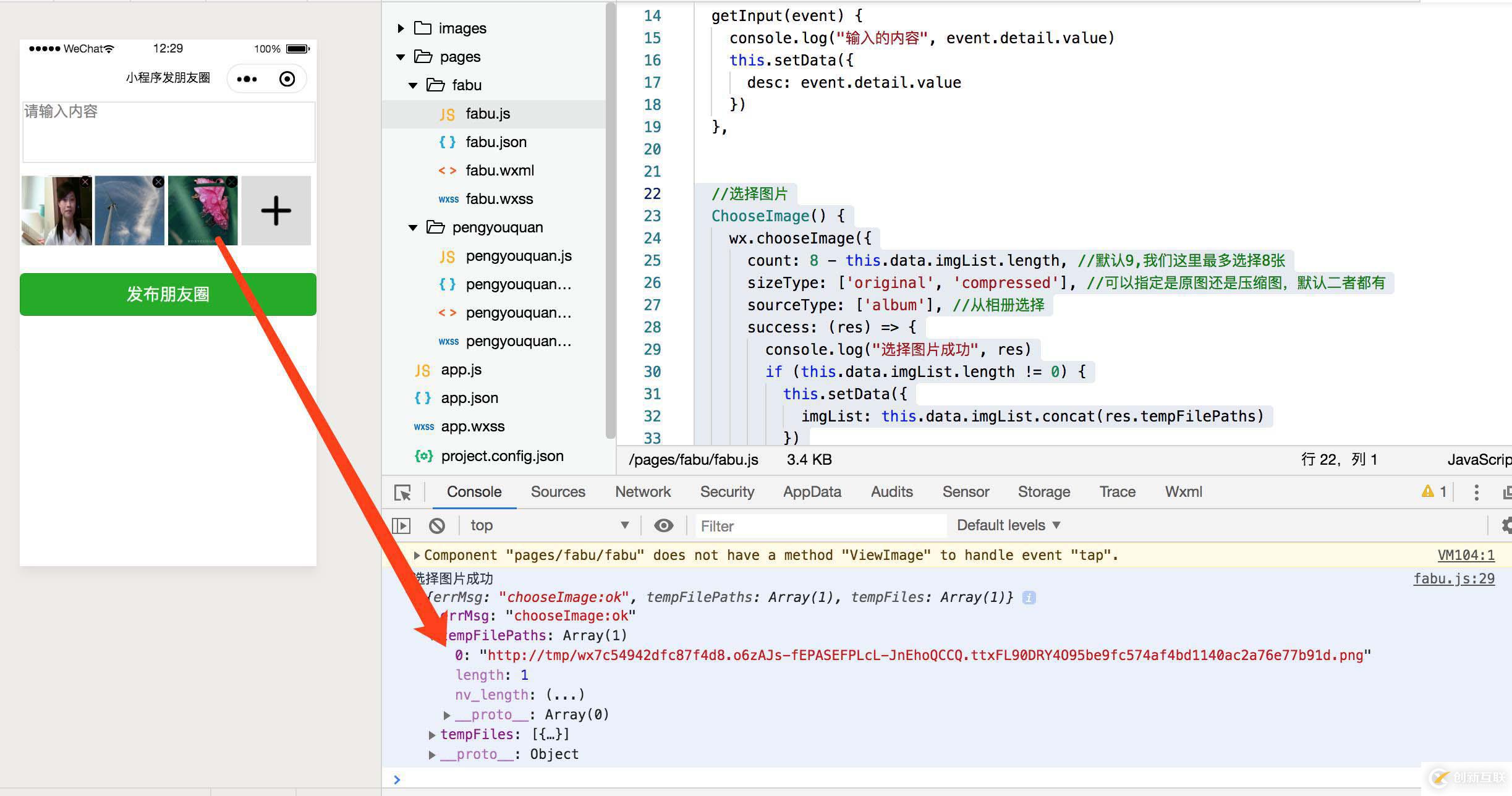
四,實(shí)現(xiàn)圖片刪除功能
我們每張圖片的右上角有個(gè)刪除按鈕,點(diǎn)擊刪除按鈕可以實(shí)現(xiàn)圖片的刪除。
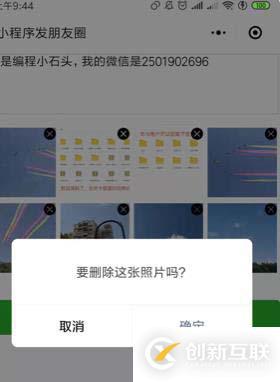
這里比較簡(jiǎn)單,把代碼貼給大家
//刪除圖片
DeleteImg(e) {
wx.showModal({
title: '要?jiǎng)h除這張照片嗎?',
content: '',
cancelText: '取消',
confirmText: '確定',
success: res => {
if (res.confirm) {
this.data.imgList.splice(e.currentTarget.dataset.index, 1);
this.setData({
imgList: this.data.imgList
})
}
}
})
},五,發(fā)布功能
- 1,發(fā)布之前我們需要先校驗(yàn)下內(nèi)容和圖片是否為空

2,由于我們發(fā)布的時(shí)候要保證所有的圖片都要上傳成功,所以這里我們這么處理。
const promiseArr = [] //只能一張張上傳 遍歷臨時(shí)的圖片數(shù)組 for (let i = 0; i < this.data.imgList.length; i++) { let filePath = this.data.imgList[i] let suffix = /\.[^\.]+$/.exec(filePath)[0]; // 正則表達(dá)式,獲取文件擴(kuò)展名 //在每次上傳的時(shí)候,就往promiseArr里存一個(gè)promise,只有當(dāng)所有的都返回結(jié)果時(shí),才可以繼續(xù)往下執(zhí)行 promiseArr.push(new Promise((reslove, reject) => { wx.cloud.uploadFile({ cloudPath: new Date().getTime() + suffix, filePath: filePath, // 文件路徑 }).then(res => { // get resource ID console.log("上傳結(jié)果", res.fileID) this.setData({ fileIDs: this.data.fileIDs.concat(res.fileID) }) reslove() }).catch(error => { console.log("上傳失敗", error) }) })) } //保證所有圖片都上傳成功 Promise.all(promiseArr).then(res => { //圖片上傳成功了,才會(huì)執(zhí)行到這。。。 })我們這里用Promise來確保所有的圖片都上傳成功了,才執(zhí)行后面的操作。
把完整的發(fā)布代碼貼給大家吧
/** * 編程小石頭 * wehchat:2501902696 */ let app = getApp(); Page({ data: { imgList: [], fileIDs: [], desc: '' }, //獲取輸入內(nèi)容 getInput(event) { console.log("輸入的內(nèi)容", event.detail.value) this.setData({ desc: event.detail.value }) }, //選擇圖片 ChooseImage() { wx.chooseImage({ count: 8 - this.data.imgList.length, //默認(rèn)9,我們這里最多選擇8張 sizeType: ['original', 'compressed'], //可以指定是原圖還是壓縮圖,默認(rèn)二者都有 sourceType: ['album'], //從相冊(cè)選擇 success: (res) => { console.log("選擇圖片成功", res) if (this.data.imgList.length != 0) { this.setData({ imgList: this.data.imgList.concat(res.tempFilePaths) }) } else { this.setData({ imgList: res.tempFilePaths }) } } }); }, //刪除圖片 DeleteImg(e) { wx.showModal({ title: '要?jiǎng)h除這張照片嗎?', content: '', cancelText: '取消', confirmText: '確定', success: res => { if (res.confirm) { this.data.imgList.splice(e.currentTarget.dataset.index, 1); this.setData({ imgList: this.data.imgList }) } } }) }, //上傳數(shù)據(jù) publish() { let desc = this.data.desc let imgList = this.data.imgList if (!desc || desc.length < 6) { wx.showToast({ icon: "none", title: '內(nèi)容大于6個(gè)字' }) return } if (!imgList || imgList.length < 1) { wx.showToast({ icon: "none", title: '請(qǐng)選擇圖片' }) return } wx.showLoading({ title: '發(fā)布中...', }) const promiseArr = [] //只能一張張上傳 遍歷臨時(shí)的圖片數(shù)組 for (let i = 0; i < this.data.imgList.length; i++) { let filePath = this.data.imgList[i] let suffix = /\.[^\.]+$/.exec(filePath)[0]; // 正則表達(dá)式,獲取文件擴(kuò)展名 //在每次上傳的時(shí)候,就往promiseArr里存一個(gè)promise,只有當(dāng)所有的都返回結(jié)果時(shí),才可以繼續(xù)往下執(zhí)行 promiseArr.push(new Promise((reslove, reject) => { wx.cloud.uploadFile({ cloudPath: new Date().getTime() + suffix, filePath: filePath, // 文件路徑 }).then(res => { // get resource ID console.log("上傳結(jié)果", res.fileID) this.setData({ fileIDs: this.data.fileIDs.concat(res.fileID) }) reslove() }).catch(error => { console.log("上傳失敗", error) }) })) } //保證所有圖片都上傳成功 Promise.all(promiseArr).then(res => { wx.cloud.database().collection('timeline').add({ data: { fileIDs: this.data.fileIDs, date: app.getNowFormatDate(), createTime: db.serverDate(), desc: this.data.desc, images: this.data.imgList }, success: res => { wx.hideLoading() wx.showToast({ title: '發(fā)布成功', }) console.log('發(fā)布成功', res) wx.navigateTo({ url: '../pengyouquan/pengyouquan', }) }, fail: err => { wx.hideLoading() wx.showToast({ icon: 'none', title: '網(wǎng)絡(luò)不給力....' }) console.error('發(fā)布失敗', err) } }) }) }, })到這里我們發(fā)布的功能就實(shí)現(xiàn)了,發(fā)布功能就如下面這個(gè)流程圖所示。
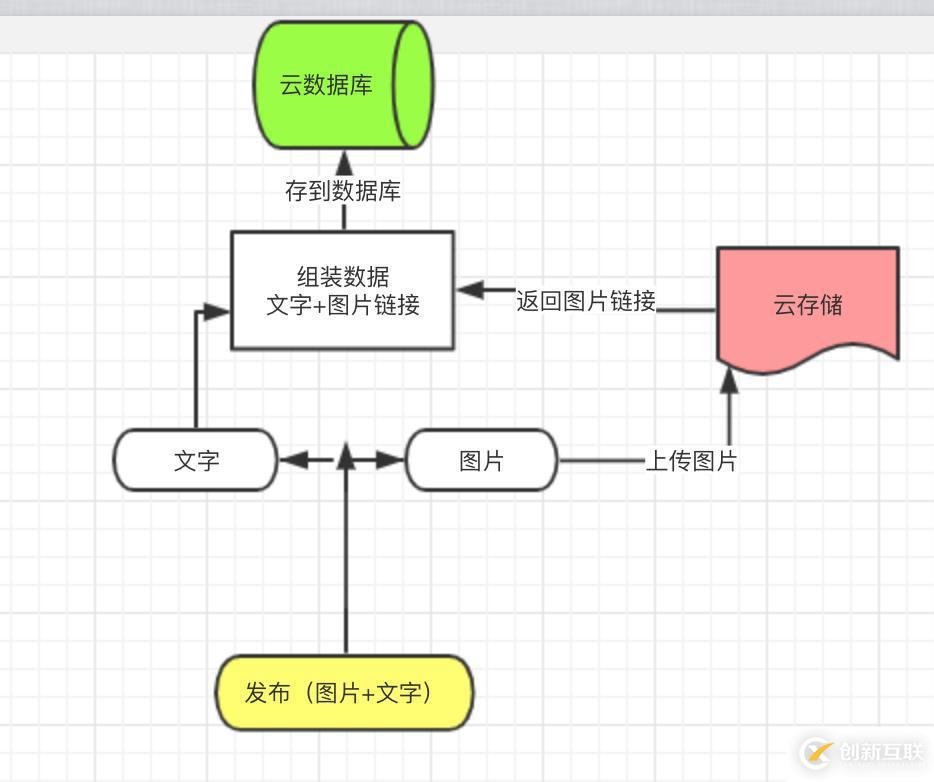
我們最終的目的是要把文字和圖片鏈接存到云數(shù)據(jù)庫。把圖片文件存到云存儲(chǔ)。這就是云開發(fā)的方便之處,不用我們編寫后臺(tái)代碼,就可以輕松實(shí)現(xiàn)后臺(tái)功能。
接下來講朋友圈展示頁。

這個(gè)頁面主要做的就是
- 1,從云數(shù)據(jù)庫讀取數(shù)據(jù)
- 2,展示列表數(shù)據(jù)
1,讀取數(shù)據(jù)
這里讀取數(shù)據(jù)挺簡(jiǎn)單,就是從云數(shù)據(jù)庫讀數(shù)據(jù),這里我們做了一個(gè)排序,就是最新發(fā)布的數(shù)據(jù)在最上面。代碼如下
wx.cloud.database().collection('timeline')
.orderBy('createTime', 'desc') //按發(fā)布視頻排序
.get({
success(res) {
console.log("請(qǐng)求成功", res)
that.setData({
dataList: res.data
})
},
fail(res) {
console.log("請(qǐng)求失敗", res)
}
})云數(shù)據(jù)庫的讀取也比較簡(jiǎn)單,有不會(huì)的同學(xué),或者沒有聽說過小程序云開發(fā)的同學(xué),可以去翻看下我之前發(fā)的文章,也可以看下我錄的《10小時(shí)零基礎(chǔ)入門小程序云開發(fā)》
2,朋友圈列表的展示
這里也比較簡(jiǎn)單,直接把布局代碼貼給大家。dataList就是我們第一步請(qǐng)求到的數(shù)據(jù)。
<block wx:for="{{dataList}}" wx:key="index">
<view class="itemRoot">
<view>
<text class="desc">{{item.desc}}</text>
</view>
<view class="imgRoot">
<block class="imgList" wx:for="{{item.fileIDs}}" wx:for-item="itemImg" wx:key="index">
<image class="img" src='{{itemImg}}' mode='aspectFill' data-img='{{[itemImg,item.fileIDs]}}' bindtap="previewImg"></image>
</block>
</view>
</view>
</block>3,這里還有一個(gè)圖片預(yù)覽的功能
功能實(shí)現(xiàn)很簡(jiǎn)單就下面幾行代碼,但是我們從wxml獲取組件上的數(shù)據(jù)時(shí)比較麻煩。
// 預(yù)覽圖片
previewImg: function(e) {
let imgData = e.currentTarget.dataset.img;
console.log("eeee", imgData[0])
console.log("圖片s", imgData[1])
wx.previewImage({
//當(dāng)前顯示圖片
current: imgData[0],
//所有圖片
urls: imgData[1]
})
},4,點(diǎn)擊圖片時(shí)通過 data- 獲取圖片列表和當(dāng)前圖片數(shù)據(jù)
我們點(diǎn)擊組件時(shí),可以通過data- 傳遞數(shù)據(jù),但是一個(gè)點(diǎn)擊如果像傳多條數(shù)據(jù)呢。這時(shí)候可以用 data-xxx='{{[xxx,xxx]}}' 來傳遞數(shù)據(jù)了。如下代碼
<block wx:for="{{item.fileIDs}}" wx:key="item2" wx:for-item="item2">
<image src='{{item2}}' data-img='{{[item2,item.fileIDs]}}' mode='aspectFill' bindtap="previewImg"></image>
</block>
//我們?cè)賘s里可以接收兩個(gè)數(shù)據(jù)
previewImg: function(e) {
let imgData = e.currentTarget.dataset.img;
console.log("item2", imgData[0])
console.log("item.fileIDs", imgData[1])
//大圖預(yù)覽
wx.previewImage({
//當(dāng)前顯示圖片
current: imgData[0],
//所有圖片
urls: imgData[1]
})
},上面代碼就可以實(shí)現(xiàn),一次點(diǎn)擊,通過data- 傳遞多個(gè)數(shù)據(jù)到j(luò)s里。
到這里我們就完整的實(shí)現(xiàn)了,朋友圈的發(fā)布與展示了

朋友圈展示的比較簡(jiǎn)陋,后期再抽時(shí)間做美化吧。
源碼我已經(jīng)上傳到網(wǎng)盤,需要的同學(xué)可以加我微信2501902696獲取
.jpg)
后面我也會(huì)錄制一套視頻來專門講解。敬請(qǐng)關(guān)注。
本文標(biāo)題:借助云開發(fā)實(shí)現(xiàn)小程序朋友圈的發(fā)布與展示
路徑分享:http://www.chinadenli.net/article32/ishhsc.html
成都網(wǎng)站建設(shè)公司_創(chuàng)新互聯(lián),為您提供全網(wǎng)營銷推廣、網(wǎng)站建設(shè)、外貿(mào)建站、品牌網(wǎng)站建設(shè)、面包屑導(dǎo)航、手機(jī)網(wǎng)站建設(shè)
聲明:本網(wǎng)站發(fā)布的內(nèi)容(圖片、視頻和文字)以用戶投稿、用戶轉(zhuǎn)載內(nèi)容為主,如果涉及侵權(quán)請(qǐng)盡快告知,我們將會(huì)在第一時(shí)間刪除。文章觀點(diǎn)不代表本網(wǎng)站立場(chǎng),如需處理請(qǐng)聯(lián)系客服。電話:028-86922220;郵箱:631063699@qq.com。內(nèi)容未經(jīng)允許不得轉(zhuǎn)載,或轉(zhuǎn)載時(shí)需注明來源: 創(chuàng)新互聯(lián)

- 我應(yīng)該如何選擇網(wǎng)站虛擬主機(jī)? 2022-09-26
- 阿里云云虛擬主機(jī)更改操作系統(tǒng)流程 2022-10-12
- 自己做網(wǎng)站 虛擬主機(jī)選擇一定不能忽視 2016-11-16
- 虛擬主機(jī)服務(wù)器網(wǎng)絡(luò)空間的時(shí)代化意義 2021-05-04
- 虛擬主機(jī)空間通常支持多少人在線? 2018-10-10
- 云服務(wù)器和虛擬主機(jī)的特點(diǎn)及其區(qū)別 2022-08-24
- N點(diǎn)虛擬主機(jī)管理系統(tǒng)重置密碼方法(在線修改密碼) 2022-10-02
- 虛擬主機(jī)iis連接數(shù)的含義及難題解析 2022-10-02
- 虛擬主機(jī)哪家好 2022-07-23
- 一個(gè)不穩(wěn)定的虛擬主機(jī)會(huì)產(chǎn)生什么后果? 2021-02-26
- 現(xiàn)在什么虛擬主機(jī)好用? 2022-10-09
- 解析網(wǎng)站建設(shè)為何要選擇虛擬主機(jī) 2020-08-04